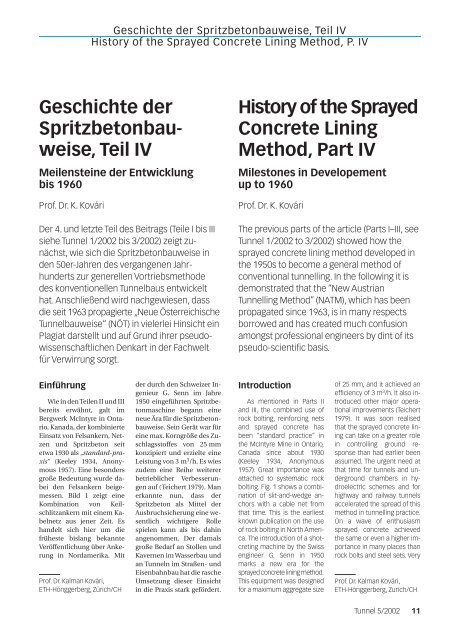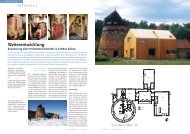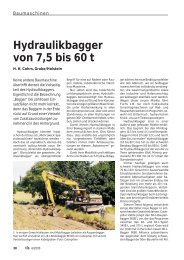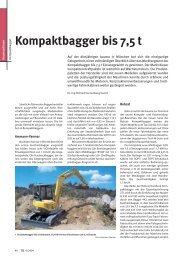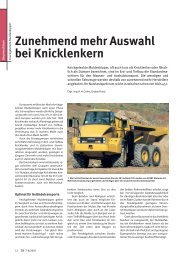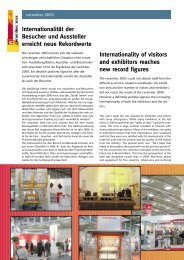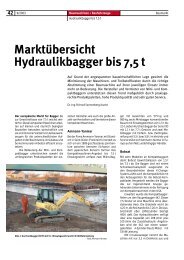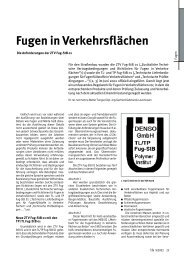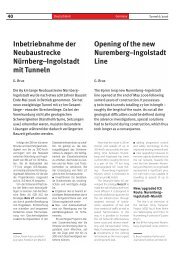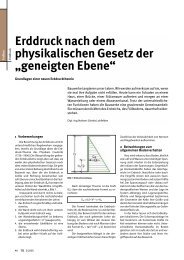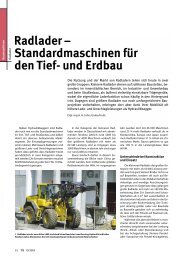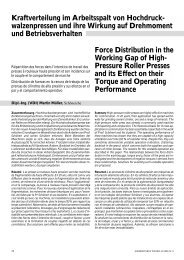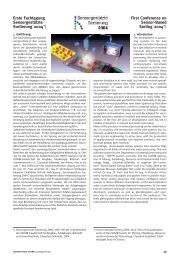Geschichte der Spritzbetonbauweise, Teil IV - Bauverlag
Geschichte der Spritzbetonbauweise, Teil IV - Bauverlag
Geschichte der Spritzbetonbauweise, Teil IV - Bauverlag
Erfolgreiche ePaper selbst erstellen
Machen Sie aus Ihren PDF Publikationen ein blätterbares Flipbook mit unserer einzigartigen Google optimierten e-Paper Software.
<strong>Geschichte</strong> <strong>der</strong> <strong>Spritzbetonbauweise</strong>, <strong>Teil</strong> <strong>IV</strong><br />
History of the Sprayed Concrete Lining Method, P. <strong>IV</strong><br />
<strong>Geschichte</strong> <strong>der</strong><br />
<strong>Spritzbetonbauweise</strong>,<br />
<strong>Teil</strong> <strong>IV</strong><br />
Meilensteine <strong>der</strong> Entwicklung<br />
bis 1960<br />
Prof. Dr. K. Kovári<br />
Der 4. und letzte <strong>Teil</strong> des Beitrags (<strong>Teil</strong>e I bis III<br />
siehe Tunnel 1/2002 bis 3/2002) zeigt zunächst,<br />
wie sich die <strong>Spritzbetonbauweise</strong> in<br />
den 50er-Jahren des vergangenen Jahrhun<strong>der</strong>ts<br />
zur generellen Vortriebsmethode<br />
des konventionellen Tunnelbaus entwickelt<br />
hat. Anschließend wird nachgewiesen, dass<br />
die seit 1963 propagierte „Neue Österreichische<br />
Tunnelbauweise“ (NÖT) in vielerlei Hinsicht ein<br />
Plagiat darstellt und auf Grund ihrer pseudowissenschaftlichen<br />
Denkart in <strong>der</strong> Fachwelt<br />
für Verwirrung sorgt.<br />
History of the Sprayed<br />
Concrete Lining<br />
Method, Part <strong>IV</strong><br />
Milestones in Developement<br />
up to 1960<br />
Prof. Dr. K. Kovári<br />
The previous parts of the article (Parts I–III, see<br />
Tunnel 1/2002 to 3/2002) showed how the<br />
sprayed concrete lining method developed in<br />
the 1950s to become a general method of<br />
conventional tunnelling. In the following it is<br />
demonstrated that the “New Austrian<br />
Tunnelling Method” (NATM), which has been<br />
propagated since 1963, is in many respects<br />
borrowed and has created much confusion<br />
amongst professional engineers by dint of its<br />
pseudo-scientific basis.<br />
Einführung<br />
Wie in den <strong>Teil</strong>en II und III<br />
bereits erwähnt, galt im<br />
Bergwerk McIntyre in Ontario,<br />
Kanada, <strong>der</strong> kombinierte<br />
Einsatz von Felsankern, Netzen<br />
und Spritzbeton seit<br />
etwa 1930 als „standard-praxis“<br />
(Keeley 1934, Anonymous<br />
1957). Eine beson<strong>der</strong>s<br />
große Bedeutung wurde dabei<br />
den Felsankern beigemessen.<br />
Bild 1 zeigt eine<br />
Kombination von Keilschlitzankern<br />
mit einem Kabelnetz<br />
aus jener Zeit. Es<br />
handelt sich hier um die<br />
früheste bislang bekannte<br />
Veröffentlichung über Ankerung<br />
in Nordamerika. Mit<br />
Prof. Dr. Kalman Kovári,<br />
ETH-Hönggerberg, Zürich/CH<br />
<strong>der</strong> durch den Schweizer Ingenieur<br />
G. Senn im Jahre<br />
1950 eingeführten Spritzbetonmaschine<br />
begann eine<br />
neue Ära für die <strong>Spritzbetonbauweise</strong>.<br />
Sein Gerät war für<br />
eine max. Korngröße des Zuschlagsstoffes<br />
von 25 mm<br />
konzipiert und erzielte eine<br />
Leistung von 3 m 3 /h. Es wies<br />
zudem eine Reihe weiterer<br />
betrieblicher Verbesserungen<br />
auf (Teichert 1979). Man<br />
erkannte nun, dass <strong>der</strong><br />
Spritzbeton als Mittel <strong>der</strong><br />
Ausbruchsicherung eine wesentlich<br />
wichtigere Rolle<br />
spielen kann als bis dahin<br />
angenommen. Der damals<br />
große Bedarf an Stollen und<br />
Kavernen im Wasserbau und<br />
an Tunneln im Straßen- und<br />
Eisenbahnbau hat die rasche<br />
Umsetzung dieser Einsicht<br />
in die Praxis stark geför<strong>der</strong>t.<br />
Introduction<br />
As mentioned in Parts II<br />
and III, the combined use of<br />
rock bolting, reinforcing nets<br />
and sprayed concrete has<br />
been “standard practice” in<br />
the McIntyre Mine in Ontario,<br />
Canada since about 1930<br />
(Keeley 1934, Anonymous<br />
1957). Great importance was<br />
attached to systematic rock<br />
bolting. Fig. 1 shows a combination<br />
of slit-and-wedge anchors<br />
with a cable net from<br />
that time. This is the earliest<br />
known publication on the use<br />
of rock bolting in North America.<br />
The introduction of a shotcreting<br />
machine by the Swiss<br />
engineer G. Senn in 1950<br />
marks a new era for the<br />
sprayed concrete lining method.<br />
This equipment was designed<br />
for a maximum aggregate size<br />
of 25 mm, and it achieved an<br />
efficiency of 3 m 3 /h. It also introduced<br />
other major operational<br />
improvements (Teichert<br />
1979). It was soon realised<br />
that the sprayed concrete lining<br />
can take on a greater role<br />
in controlling ground response<br />
than had earlier been<br />
assumed. The urgent need at<br />
that time for tunnels and un<strong>der</strong>ground<br />
chambers in hydroelectric<br />
schemes and for<br />
highway and railway tunnels<br />
accelerated the spread of this<br />
method in tunnelling practice.<br />
On a wave of enthusiasm<br />
sprayed concrete achieved<br />
the same or even a higher importance<br />
in many places than<br />
rock bolts and steel sets. Very<br />
Prof. Dr. Kalman Kovári,<br />
ETH-Hönggerberg, Zurich/CH<br />
Tunnel 5/2002 11
<strong>Geschichte</strong> <strong>der</strong> <strong>Spritzbetonbauweise</strong>, <strong>Teil</strong> <strong>IV</strong><br />
History of the Sprayed Concrete Lining Method, P. <strong>IV</strong><br />
1 Detailzeichnung einer Ausbruchsicherung mit Felsankern und<br />
einem Netz aus Kabeln; McIntyre Grube, Kanada (Keeley 1934)<br />
1 Detail drawing of rock support with slit-and-wedge bolts and<br />
cable hanger; McIntyre Mine, Canada (Keeley 1934)<br />
In einer Welle <strong>der</strong> Begeisterung<br />
erlangte <strong>der</strong> Spritzbeton<br />
vielerorts eine ebenbürtige<br />
o<strong>der</strong> gar höhere Bedeutung<br />
als Felsanker und Stahleinbau.<br />
Sehr bald setzte sich<br />
jedoch die Erkenntnis durch,<br />
dass in den meisten Fällen<br />
erst eine systematische Kombination<br />
dieser Stützmittel<br />
das statisch wirksamste und<br />
zugleich wirtschaftlichste Mittel<br />
zur Kontrolle des Gebirgsdruckes<br />
bzw. <strong>der</strong> Gebirgsverformung<br />
darstellt.<br />
Der durch Wegfall <strong>der</strong><br />
Zimmerung frei gewordene<br />
Arbeitsraum und die vielfältigen<br />
Einsatzmöglichkeiten<br />
<strong>der</strong> Stützmittel bezüglich<br />
Zeitpunkt und Lage öffnete<br />
den Weg zu einer Reihe<br />
neuartiger Vortriebskonzepte.<br />
Diese fasste man unter<br />
dem Sammelbegriff „<strong>Spritzbetonbauweise</strong>“<br />
zusammen.<br />
So verschieden die Methoden<br />
des Ausbruchs (Sprengen,<br />
Schrämmen, Baggern,<br />
etc.), die Bau- und Betriebsweisen<br />
sowie die Profilformen<br />
(mit o<strong>der</strong> ohne Sohlgewölbe)<br />
auch sein mochten,<br />
das Gemeinsame bildete das<br />
einheitliche äußere Erscheinungsbild<br />
zufolge <strong>der</strong> Spritzbetonverkleidung.<br />
Der Ausdruck<br />
„<strong>Spritzbetonbauweise</strong>“<br />
bezog sich somit einzig und<br />
allein auf technologische<br />
Merkmale, wobei es als<br />
selbstverständlich galt, die<br />
bis dahin vorliegenden wissenschaftlichen<br />
Erkenntnisse<br />
für Planung und Ausführung<br />
zu verwerten.<br />
Die oben genannte Spritzbetonmaschine<br />
wurde in<br />
großem Umfang zum ersten<br />
Mal 1952 im 26,7 km langen<br />
Verbano Wasserstollen (Ausbruchfläche<br />
21,4 m 2 ) <strong>der</strong><br />
Maggia-Kraftwerke, Schweiz,<br />
eingesetzt. Gemäß dem Vertreter<br />
<strong>der</strong> Bauleitung (Son<strong>der</strong>egger<br />
1955) „wurde zur<br />
sofortigen Sicherung von gebrächen<br />
Felspartien mit gutem<br />
Erfolg auch Spritzbeton<br />
anstelle von provisorischem<br />
Ausbau aufgetragen. (...) Die<br />
Wirkung von Gunit und<br />
Spritzbeton ist wohl in dem<br />
Umstand zu suchen, dass die<br />
feinen Klüfte zwischen den<br />
Felsteilchen satt ausgefüllt<br />
werden. Dadurch wird eine<br />
ausweichende Bewegung <strong>der</strong><br />
Gesteinsteilchen von Anfang<br />
an erschwert“. In einer an<strong>der</strong>en<br />
Publikation (Son<strong>der</strong>egger<br />
1956) wies er darauf hin,<br />
dass „<strong>der</strong> Zwischenraum zwischen<br />
Einbaubogen und Unterlage<br />
mit Spritzbeton satt<br />
ausgefüllt wird, wobei kleine<br />
sekundäre Gewölbe zwischen<br />
den Einbauten entstehen. Ein<br />
seitliches Ausknicken <strong>der</strong><br />
Einbaubogen wird auf diese<br />
Weise erschwert“. Aus einer<br />
bemerkenswerten Veröffentlichung<br />
von Frey-Bär (1956)<br />
geht hervor, wie sehr sich die<br />
verantwortlichen Ingenieure<br />
schon damals <strong>der</strong> Bedeutung<br />
dieser Entwicklungen<br />
bewusst waren: „Spritzbeton<br />
mit dem vorstehend beschriebenen<br />
Ankereinbau kombiniert<br />
hat sich schon dort<br />
soon, however, it was realized<br />
that in many cases a combination<br />
of these support elements<br />
provides the most efficient<br />
method both structurally<br />
and economically for controlling<br />
rock pressures and<br />
ground response.<br />
The space gained by not<br />
having timber supports and<br />
the wide possibilities offered<br />
by the application of the new<br />
methods of support in relation<br />
to time and place opened the<br />
way for a series of novel excavation<br />
concepts. These were<br />
collectively known as the<br />
“sprayed concrete construction<br />
method”. Just as the<br />
methods of excavation (blasting,<br />
cutting, digging, etc.), the<br />
procedures in cross-section<br />
and in longitudinal direction<br />
as well as the shape of the<br />
tunnel profiles (with or without<br />
invert arch) greatly differed<br />
from one another, together<br />
they presented a uniform<br />
external appearance as<br />
a result of the sprayed concrete<br />
lining.The term “sprayed<br />
concrete construction method”<br />
(<strong>Spritzbetonbauweise</strong> in German)<br />
therefore was related<br />
purely to technological features,<br />
whereby it was taken<br />
for granted that the existing<br />
scientific knowledge relating<br />
to planning and execution<br />
should be exploited.<br />
The above mentioned<br />
shotcrete machine was first<br />
applied on a large scale in<br />
1952 in the 26.7 km long Verbano<br />
waterway tunnel (with an<br />
excavated section of 21.4 m 2 )<br />
for the Maggia Hydroelectric<br />
Scheme in Switzerland. According<br />
to the resident engineer<br />
(Son<strong>der</strong>egger 1955),<br />
“Shotcrete was applied with<br />
great success in place of a<br />
temporary support as an immediate<br />
support in sections of<br />
weak rock. (...) The effect of<br />
gunite and shotcrete is seen in<br />
completely filling the fine<br />
joints between the blocks of<br />
rock. In this way, from the outset,<br />
movement of rock blocks<br />
is impeded”. In another publication<br />
(Son<strong>der</strong>egger 1956) he<br />
also drew attention to the fact<br />
that “the gap between the<br />
steel sets and the base was<br />
completely filled with shotcrete,<br />
forming a secondary<br />
arch between them. In this<br />
way lateral buckling of the<br />
arches is hin<strong>der</strong>ed” (Fig.1). A<br />
remarkable publication by<br />
Frey-Bär (1956) reveals the responsible<br />
engineers’ consciousness<br />
of the importance<br />
of these developments: “Shotcrete<br />
in combination with the<br />
rock bolting previously described<br />
is an excellent means<br />
of support where earlier timeconsuming<br />
heavy timbering<br />
was required. With shotcrete,<br />
engineers have a means at<br />
their disposal with several advantages:<br />
extremely adaptable<br />
in application with regard<br />
to the thickness applied to the<br />
rock and the extent of the area<br />
covered. The tunnel advance<br />
is hardly affected”. Furthermore,<br />
he observes “shotcrete<br />
lining sprayed immediately af-<br />
12 Tunnel 5/2002
<strong>Geschichte</strong> <strong>der</strong> <strong>Spritzbetonbauweise</strong>, <strong>Teil</strong> <strong>IV</strong><br />
History of the Sprayed Concrete Lining Method, P. <strong>IV</strong><br />
2 Spritzbeton und Anker bei den Maggia-Kraftwerken, Schweiz, 1952–1955 (Fotos D. Pra<strong>der</strong>)<br />
2 Use of shotcrete and bolts in the waterway tunnels of the Maggia Hydroelectric Scheme, Switzerland 1952–1955<br />
(Photos courtesy of D. Pra<strong>der</strong>)<br />
ausgezeichnet bewährt, wo<br />
früher ein zeitrauben<strong>der</strong><br />
schwerer Holzeinbau angeordnet<br />
wurde. Mit dem<br />
Spritzbeton ist dem Stollenbauer<br />
ein Mittel in die Hand<br />
gegeben, dessen Anwendung<br />
sehr anpassungsfähig ist, sowohl<br />
in <strong>der</strong> Stärke des Auftrages,<br />
als auch in den Flächenabmessungen.<br />
Die Ausführung<br />
stört den Vortrieb nur<br />
ganz kurzfristig“. Ferner<br />
stellte er fest, dass „ein direkt<br />
hinter dem Vortrieb aufgespritztes<br />
Gewölbe in den<br />
meisten Fällen den nachfolgenden<br />
Wirkungen des Gebirgsdruckes<br />
standhält“. Frey-<br />
Bär schließt seine Ausführungen<br />
mit einem detaillierten<br />
Kostenvergleich <strong>der</strong> einzelnen<br />
Stützmittel je Tunnelmeter<br />
und sagt: „Es ist dabei<br />
zu bedenken, dass die drei eigentlich<br />
ganz verschiedenen<br />
Einbauarten (Anker, Spritzbeton<br />
und Stahlbogen) sehr<br />
wohl miteinan<strong>der</strong> kombiniert<br />
werden können“. Der<br />
österreichische Ingenieur<br />
Rabcewicz schrieb 1964 rückblickend:<br />
„Die erste erfolgreiche<br />
Anwendung <strong>der</strong> Oberflächenstabilisierung<br />
mittels<br />
Spritzbeton für Tunnel in instabilem<br />
Gebirge als integrieren<strong>der</strong><br />
Bestandteil des Vortriebes<br />
anstelle <strong>der</strong> Verwendung<br />
von Zimmerung o<strong>der</strong><br />
Stahleinbau wurde in dem<br />
Lodano-Mosogno Stollen für<br />
die Maggia-Kraftwerke in <strong>der</strong><br />
Schweiz zwischen 1951 und<br />
1955 durchgeführt“ (Bild 2).<br />
Im Hinblick auf den seit 1920<br />
weltweit erfolgten Einsatz<br />
des Spritzbetons ist diese Behauptung<br />
selbstredend falsch.<br />
Sie zeigt lediglich, dass <strong>der</strong><br />
Autor erst nach dieser Anwendung<br />
die Bedeutung des<br />
Spritzbetons als Stützmittel<br />
erkannt hat.<br />
In Österreich kam Senn’s<br />
Spritzbetonmaschine (geliefert<br />
durch die Firma Aliva,<br />
Schweiz) zum ersten Mal bei<br />
<strong>der</strong> Wasserkraftanlage Prutz-<br />
Imst von 1953 bis 1955 sowie<br />
ter excavation is in most cases<br />
capable of withstanding subsequent<br />
effects of rock pressure”.<br />
Frey-Bär concludes his<br />
paper with a detailed comparison<br />
of the costs per tunnel<br />
metre of the individual support<br />
measures and says: “It is<br />
to be taken into consi<strong>der</strong>ation<br />
that the three quite different<br />
support elements (rock bolts,<br />
shotcrete and steel sets) can<br />
perfectly well be used in combination”.<br />
The Austrian engineer<br />
Rabcewicz wrote in 1964 in<br />
retrospect: “The first successful<br />
application of surface stabilisation<br />
by means of shotcrete<br />
for tunnels in unstable<br />
ground as an integral part of<br />
the driving process, instead of<br />
using timber or steel, was for<br />
the Lodano-Losogno tunnel of<br />
the Maggia Hydroelectric<br />
Scheme, in Switzerland, 1951-<br />
1955” (Fig. 2). In view of the<br />
continuous worldwide application<br />
of sprayed concrete<br />
since 1920, this statement is<br />
of course, not true. It was only<br />
after this use of sprayed concrete<br />
that Rabcewicz himself<br />
discovered its importance as<br />
a means of support.<br />
In Austria, Senn’s shotcreting<br />
machine (supplied at that<br />
time by the Swiss firm AL<strong>IV</strong>A)<br />
was first applied in the Prutz-<br />
Imst Hydroelectric Plant from<br />
1953–1954 and for the<br />
Schwarzach Plant from 1954–<br />
55 (Rotter 1958). As to the use<br />
of sprayed concrete in mining<br />
in Austria, “The Bleiberg mine<br />
can claim to be the first mine<br />
in Austria that had the<br />
courage to break new ground<br />
in the field of sprayed concrete<br />
(AL<strong>IV</strong>A machine 1957) –<br />
apart from a first test in the<br />
Salt Mine Bad Ischl in 1953”<br />
(Rainer 1961). In Italy in 1958,<br />
the 15.2 km long waterway<br />
tunnel (Ø = 7 m) for the<br />
Monastero Hydroelectric Plant<br />
(Como) was lined with shotcrete<br />
using the previously<br />
mentioned shotcreting machine.<br />
Worthy of note is the<br />
Tunnel 5/2002 13
<strong>Geschichte</strong> <strong>der</strong> <strong>Spritzbetonbauweise</strong>, <strong>Teil</strong> <strong>IV</strong><br />
History of the Sprayed Concrete Lining Method, P. <strong>IV</strong><br />
beim Schwarzach-Kraftwerk<br />
von 1954 bis 1955 zum Einsatz<br />
(Rotter 1958). Was die<br />
Verwendung von Spritzbeton<br />
im österreichischen<br />
Bergbau betrifft, „darf <strong>der</strong><br />
Bergbau Bleiberg für sich in<br />
Anspruch nehmen, in Österreich<br />
<strong>der</strong> erste Grubenbetrieb<br />
gewesen zu sein, <strong>der</strong> sich auf<br />
das Neuland des Betonspritzens<br />
gewagt hat (Aliva machine<br />
1957), wenn man von<br />
einem Versuch im Salzbergwerk<br />
Bad Ischl, <strong>der</strong> im Jahre<br />
1953 stattfand, absieht“ (Rainer<br />
1961). In Italien erfolgte<br />
die Ausbruchsicherung eines<br />
15,2 km langen Wasserstollens<br />
(Ø = 7 m) des Monastero<br />
Kraftwerkes (Como) im<br />
Jahre 1958 durch eine Spritzbetonschale<br />
mittels <strong>der</strong> erwähnten<br />
Spritzbetonmaschine.<br />
Bemerkenswert ist dabei<br />
die Profilgestaltung (Bild 3)<br />
und die frühe Anwendung<br />
von Gitterträgern. Ein umfassen<strong>der</strong><br />
Bericht des Unternehmers<br />
(Curzio 1963) über<br />
diese Arbeiten wie auch über<br />
die Erfahrungen mit <strong>der</strong><br />
<strong>Spritzbetonbauweise</strong> für Straßentunnel<br />
bei großem Ausbruchprofil<br />
trägt den typischen<br />
Titel „Neue Vortriebssysteme<br />
im Tunnelbau“. Aus<br />
diesem Bericht geht im übrigen<br />
hervor, dass bei diesen<br />
Baustellen die Durchführung<br />
systematischer Deformationsmessungen<br />
unter <strong>der</strong> Aufsicht<br />
von G. Oberti (ISMES,<br />
Bergamo) einen integrierenden<br />
Bestandteil des Vortriebskonzeptes<br />
darstellte.<br />
In <strong>der</strong> Periode zwischen 1958<br />
und 1960 wurde zum <strong>Teil</strong><br />
auch <strong>der</strong> Tunnel Serra Ripoli<br />
<strong>der</strong> „Autostrada del sole“ mit<br />
<strong>der</strong> <strong>Spritzbetonbauweise</strong><br />
vorgetrieben (Zanon 1960).<br />
Rückblickend darf festgehalten<br />
werden, dass zu Beginn<br />
<strong>der</strong> 60er-Jahre des vergangenen<br />
Jahrhun<strong>der</strong>ts die<br />
<strong>Spritzbetonbauweise</strong> voll entwickelt<br />
war. Die neuen Stützshape<br />
of the profile (Fig. 3) and<br />
the early application of lattice<br />
gir<strong>der</strong>s. A more detailed publication<br />
by the contractor<br />
(Curzio 1963) on these works,<br />
as well as on experiences with<br />
the sprayed concrete lining<br />
method for large diameter<br />
road tunnels, bears the typical<br />
title: “New Systems of Tunnel<br />
Construction”. It can be seen<br />
from this report that the systematic<br />
deformation measurements<br />
carried out at<br />
these sites un<strong>der</strong> the supervision<br />
of G. Oberti (ISMES, Bergamo)<br />
were an integral part of<br />
the tunnelling concept. In the<br />
period between 1958 and<br />
1960, shotcreting was applied<br />
to some extent in the Serra<br />
Ripoli Tunnel of the „Autostrada<br />
del Sole“ (Zanon 1960).<br />
In retrospect, one can say<br />
that by the 1960s the “shotcrete<br />
method“ was firmly established.<br />
It quickly ousted<br />
timbering worldwide. The<br />
term „<strong>Spritzbetonbauweise</strong>“<br />
(“shotcrete method“) was<br />
widely used throughout the<br />
German speaking countries.<br />
Similar expressions can be<br />
found in other countries, for<br />
example “sprutbetongmetode“<br />
in Sweden.<br />
New Austrian<br />
Tunnelling Method<br />
(NATM)<br />
In a paper in 1963<br />
Rabcewicz, whose name has<br />
already been mentioned, renamed<br />
the “shotcrete method“<br />
the “New Austrian Tunnelling<br />
Method”. He speaks of a “shotcrete<br />
– rock bolting method<br />
which has been developed<br />
and tested in Austria”.<br />
Rabcewicz is even more explicit<br />
when he says that “due<br />
to its country of origin”,<br />
the method is called “New<br />
Austrian Tunnelling Method”<br />
(Rabcewicz 1963). Also in other<br />
publications, shotcrete and<br />
rock bolts are again and again<br />
3 Spritzbetonschale mit Gitterträgern im Druckstollen Monastero, Italien, 1958 (Curzio 1963)<br />
3 Use of lattice gir<strong>der</strong>s with shotcrete in the Monastero Pressure Tunnel, Italy, 1958 (Curzio 1963)<br />
14 Tunnel 5/2002
<strong>Geschichte</strong> <strong>der</strong> <strong>Spritzbetonbauweise</strong>, <strong>Teil</strong> <strong>IV</strong><br />
History of the Sprayed Concrete Lining Method, P. <strong>IV</strong><br />
mittel verdrängten weltweit<br />
rasch die Zimmerung. Der<br />
Begriff „<strong>Spritzbetonbauweise</strong>“<br />
fand in den deutschsprachigen<br />
Län<strong>der</strong>n eine allgemeine<br />
Verbreitung. Entsprechende<br />
Ausdrücke wurden auch in<br />
an<strong>der</strong>en Län<strong>der</strong>n geprägt, so<br />
etwa in Schweden (‚sprutbetongmetode‘).<br />
Neue Österreichische<br />
Tunnelbauweise<br />
(NÖT)<br />
4a 10. Grundsatz <strong>der</strong> NÖT: „Verbau und Ausbau dünnschalig“ (Müller<br />
& Fecker 1978)<br />
4a 10th principle of NATM: “Thin temporary and final linings” (Müller<br />
& Fecker 1978)<br />
Rabcewicz, den wir bereits<br />
zitiert haben, hat 1963<br />
in einer Veröffentlichung die<br />
<strong>Spritzbetonbauweise</strong> kurzerhand<br />
in „Neue Österreichische<br />
Tunnelbauweise“<br />
(NÖT) umbenannt. Er<br />
spricht dort von <strong>der</strong> „Spritzbeton-Ankerungs-Bauweise,<br />
welche in Österreich entwickelt<br />
und erprobt wurde“.<br />
Rabcewicz wird sogar noch<br />
deutlicher, wenn er sagt:<br />
„Wegen ihres Ursprungslandes<br />
wird die Methode ‚Neue<br />
Österreichische Tunnelbauweise‘<br />
genannt“ (Rabcewicz<br />
1963). Auch in weiteren<br />
Veröffentlichungen werden<br />
Spritzbeton und Anker immer<br />
wie<strong>der</strong> aufs Neue zu<br />
„Stützelementen dieser Bauweise“<br />
(Rabcewicz 1973) bzw.<br />
zu „Stützmaßnahmen <strong>der</strong><br />
NÖT“ (Rabcewicz und Pacher<br />
1976). Offiziell gibt sich<br />
die NÖT als „ein Tunnel mit<br />
offener Ortsbrust, <strong>der</strong> mit<br />
Spritzbeton und oft mit dem<br />
zusätzlichen Einsatz von Felsankern<br />
und Sprießen konstruiert<br />
wird“ (HSE Report<br />
1996). Spritzbeton und Anker<br />
bilden demnach die<br />
„NÖT-Technologie“. Auch das<br />
Österreichische Nationalkomittee<br />
<strong>der</strong> ITA äußert sich<br />
prägnant: „NÖT = NATM =<br />
<strong>Spritzbetonbauweise</strong>“ (Vavrovsky<br />
und Göbl 2000).<br />
Von Rabcewicz und an<strong>der</strong>en<br />
NÖT-Protagonisten werden<br />
zwei weitere, noch wichtigere<br />
Ansprüche erhoben:<br />
auf den Ersatz <strong>der</strong> Zimmerung<br />
sowie die Applikation<br />
einer schlankeren Tunnelverkleidung.<br />
Zu Ersterem<br />
folgendes Zitat: „Dies war<br />
eine Pionierleistung und es<br />
gehörte ungeheurer Mut dazu,<br />
an Stelle massivem Holzbzw.<br />
Stahlverbau und dicker<br />
Betonauskleidungen eine dünne<br />
Spritzbetonhaut auszuführen.<br />
Deshalb wurde dieses<br />
Konzept mit Recht als ‚Neue<br />
Österreichische Tunnelbauweise‘<br />
bezeichnet“ (Poisel<br />
und Engelke 1994). Hier sei<br />
lediglich erwähnt, dass die<br />
Ingenieure seit jeher bestrebt<br />
waren, die Zimmerung<br />
zu verlassen. So meint<br />
O’Rourke 1913 in seiner Veröffentlichung<br />
„Die Eliminierung<br />
<strong>der</strong> Zimmerung im Felstunnelbau:<br />
Ein Vorschlag“:<br />
„Alles, was zur Verringerung<br />
o<strong>der</strong> Vermeidung <strong>der</strong> Zimmerung<br />
getan werden kann, ist<br />
von größter Bedeutung für<br />
die Kunst des Tunnelbaus“.<br />
Die zweite, immer wie<strong>der</strong><br />
geäußerte Behauptung besagt,<br />
dass die Tunnelverkleidung<br />
dank <strong>der</strong> NÖT schlank<br />
gehalten werden könne und<br />
das Einziehen eines Sohlgewölbes<br />
eine Erfindung <strong>der</strong><br />
NÖT sei. Wir betrachten<br />
described as “support elements<br />
of this method of construction”,<br />
(Rabcewicz 1973) or as<br />
“NATM support measures“,<br />
(Rabcewicz and Pacher 1976).<br />
Officially NATM is defined as<br />
“a tunnel constructed using<br />
the open face excavation<br />
technique with a lining constructed<br />
of shotcrete, often<br />
with the additional use of<br />
ground anchors, bolts and<br />
dowels as appropriate”. (HSE<br />
Report 1996). Thus shotcrete<br />
and rock anchors are accordingly<br />
the main constituents of<br />
“NATM Technology”. Also the<br />
Austrian National Committee<br />
affiliated to ITA expresses itself<br />
very pointedly: “NÖT =<br />
NATM = Shotcrete Method”<br />
(Vavrovsky and Göbl 2000).<br />
In most publications two<br />
even more important claims<br />
are made by Rabcewicz and<br />
other NATM protagonists: the<br />
replacement of timbering and<br />
the use of thin tunnel linings:<br />
“This was truly pioneering<br />
work and required enormous<br />
courage to employ a thinly<br />
sprayed concrete skin instead<br />
of heavy timbering or steel<br />
supports and a thick concrete<br />
lining. Therefore this concept<br />
was justifiably called NATM”<br />
(Poisel and Engelke 1994). In<br />
passing, we would just like to<br />
4b Der Box Tunnel von Brunel,<br />
Great Western Railway, London<br />
1836 (Sandström 1963)<br />
4b Brunel’s Box Tunnel, Great<br />
Western Railway, London 1836<br />
(Sandström 1963)<br />
mention that engineers have<br />
always sought a replacement<br />
for timbering. Thus in a paper<br />
by O’Rourke from 1913 entitled<br />
“Elimination of Timbering<br />
in Rock Tunnelling: A Proposal”<br />
he goes on to say: “Anything<br />
that can be done to reduce<br />
or avoid the necessity of<br />
timbering is of the utmost importance<br />
in the art of tunnelling”.<br />
Another frequent<br />
claim is that thanks to NATM<br />
the tunnel lining can be kept<br />
thin and that an invert arch is<br />
an invention of NATM. Let us<br />
take only one example illustrating<br />
NATM’s 10th basic<br />
principle (Fig. 4a): “Thin temporary<br />
and final linings”<br />
(Müller and Fecker 1978).<br />
Thereby it is suggested that<br />
earlier – irrespective of the geological<br />
conditions – a heavy<br />
lining was always employed.<br />
Thus “today” stands for NATM<br />
tunnel and “earlier“ for tunnels<br />
of the “pre-NATM“ period.<br />
Fig. 4b indicates that such<br />
an assertion is untenable: for<br />
a tunnel profile featuring a<br />
thin lining and an invert, reference<br />
can be made to the famous<br />
Box Tunnel on the Great<br />
Western Railway designed by<br />
Brunel in 1836 (Sandström 1963).<br />
The most frequently used<br />
arguments to justify renaming<br />
Tunnel 5/2002 15
<strong>Geschichte</strong> <strong>der</strong> <strong>Spritzbetonbauweise</strong>, <strong>Teil</strong> <strong>IV</strong><br />
History of the Sprayed Concrete Lining Method, P. <strong>IV</strong><br />
dazu Bild 4a zur Illustration<br />
des 10. NÖT-Grundsatzes:<br />
„Verbau und Ausbau dünnschalig“<br />
(Müller und Fecker<br />
1978). Dem Betrachter wird<br />
suggeriert, dass man früher<br />
stets einen schweren Einbau<br />
verwendete – ungeachtet <strong>der</strong><br />
geologischen Verhältnisse.<br />
„Heute“ steht somit für die<br />
„NÖT-Tunnel“ und „früher“<br />
für jene Tunnel, die vor Einführung<br />
<strong>der</strong> NÖT gebaut<br />
wurden. Die Unhaltbarkeit<br />
solcher Behauptungen geht<br />
aus Bild 4b hervor: bei diesem<br />
Tunnelprofil mit schlanker<br />
Verkleidung und Sohlgewölbe<br />
handelt es sich um<br />
den berühmten, von Brunel<br />
1836 gebauten Box Tunnel<br />
<strong>der</strong> Great Western Railway<br />
(Sandström 1963).<br />
Die häufigsten Argumente,<br />
die das Umbenennen <strong>der</strong><br />
<strong>Spritzbetonbauweise</strong> in „Neue<br />
Österreichische Tunnelbauweise“<br />
im Nachhinein rechtfertigen<br />
sollten, sind:<br />
■ Rabcewicz habe die NÖT<br />
bereits 1948 erfunden und<br />
patentiert<br />
■ Rabcewicz habe den<br />
Spritzbeton und die Ankerung<br />
in den Tunnelbau eingeführt<br />
■ Brunner habe die NÖT erfunden<br />
und 1955 patentiert<br />
■ Die von Pacher postulierte<br />
muldenförmige Gebirgskennlinie<br />
bilde das Grundkonzept<br />
<strong>der</strong> NÖT<br />
■ Die NÖT sei im Grunde<br />
ein von Müller aufgestellter<br />
Grundsatzkatalog<br />
Nachfolgend sollen nun<br />
diese offensichtlich wi<strong>der</strong>sprüchlichen<br />
Argumente<br />
überprüft werden.<br />
Das Patent von Rabcewicz<br />
mit dem Titel „Verfahren<br />
zum Ausbau von unterirdischen<br />
Hohlräumen, insbeson<strong>der</strong>e<br />
von Tunneln“, eingereicht<br />
im Jahre 1948 und<br />
herausgegeben im Jahre<br />
1950, bezieht sich auf eine<br />
spezielle Ausbruchsicherung.<br />
Sie hat die Form einer dicken,<br />
aus Stampfbeton bestehenden<br />
Schale, die unmittelbar<br />
an <strong>der</strong> Ortsbrust zu<br />
einem Ring geschlossen wird<br />
(Rabcewicz 1948). Nach dem<br />
Betonieren des Sohlgewölbes<br />
war eine Schalung mit<br />
<strong>der</strong> kurzen Länge des Abschlages<br />
zu erstellen, um<br />
hernach das eigentliche Gewölbe<br />
zu betonieren. Erst<br />
nach dem Erhärten des Betons<br />
hätte <strong>der</strong> nächste Abschlag<br />
gemacht werden können.<br />
Eine provisorische Sicherung<br />
war überhaupt<br />
nicht vorgesehen. Im weiteren<br />
schlug er Deformationsmessungen<br />
vor, um die Entwicklung<br />
des Gebirgsdruckes<br />
zu kontrollieren, übersah<br />
jedoch, dass solche Messungen<br />
an einer <strong>der</strong>art steifen<br />
Ortbetonschale gar keinen<br />
praktischen Sinn haben<br />
(Bild 5). Die irrige Auffasthe<br />
“shotcrete method“ NATM<br />
include the following:<br />
■ Rabcewicz invented and<br />
patented NATM as early as<br />
1948.<br />
■ Rabcewicz introduced shotcreting<br />
and rock bolting to<br />
tunnelling.<br />
■ Brunner invented and<br />
patented NATM in 1955.<br />
■ Pacher postulated a characteristic<br />
trough-shaped ground<br />
response curve as a basic<br />
concept of NATM<br />
■ NATM is basically a catalogue<br />
of principles drawn up<br />
by Müller<br />
These obviously contradictory<br />
arguments are examined<br />
in the following.<br />
Rabcewicz’s patent called<br />
“Procedure for lining of un<strong>der</strong>ground<br />
openings, specifically<br />
tunnels” submitted in 1948<br />
and published in 1950 deals<br />
with a method of excavation<br />
support. It is in the form of a<br />
5 NÖT-Patent von Rabcewicz (1948): Vollausbruch mit Gewölben<br />
aus Schalungsbeton<br />
5 Rabcewicz’s NATM patent (1948) for full-face excavation with<br />
two concrete linings both erected behind a formwork<br />
tamped concrete lining, immediately<br />
closed at the face<br />
to form a ring (Rabcewicz<br />
1948). After concreting the invert<br />
arch, a lining had to be<br />
constructed over the short<br />
length of the attack, in or<strong>der</strong> to<br />
be able to subsequently concrete<br />
the actual invert arch.<br />
The next attack could first be<br />
carried out once the concrete<br />
had set. Temporary support<br />
was not foreseen at all. He<br />
also proposed deformation<br />
measurements for the purpose<br />
of controlling the development<br />
of rock pressure, but<br />
overlooked the fact that they<br />
obviously had no practical<br />
meaning due to the extreme<br />
stiffness of the lining (Fig. 5).<br />
The false claim that the NATM<br />
also represents an “observational<br />
method” partly has its<br />
origin in this erroneous idea.<br />
Rabcewicz already withdrew<br />
the patent in 1952 because in<br />
fact it was never applied in<br />
practice (Spang 1996). There is<br />
also no mention in this patent<br />
of rock bolts and shotcrete or<br />
steel arches. Despite this, he<br />
always claimed that he invented<br />
the “Shotcrete – Rock Bolt<br />
Construction Method” and allowed<br />
himself to be celebrated<br />
as its father. NATM historians<br />
also recently reported:<br />
“He patented NATM in Vienna<br />
in 1948 from his exile in South<br />
America”. (Mayr 1994). After<br />
losing his professorship at the<br />
Technical University of Vienna,<br />
he wrote a doctoral thesis<br />
(Rabcewicz 1950), in which he<br />
showed that until December<br />
1950, he had no idea at that<br />
time about the new developments<br />
in shotcrete and rock<br />
bolts. On the contrary, he was<br />
still dealing only with concrete<br />
linings with a thickness of 30<br />
cm as primary support. Even<br />
the significance of steel sets,<br />
already then fairly widespread,<br />
completely escaped<br />
his notice at the time. He first<br />
became acquainted with rock<br />
16 Tunnel 5/2002
<strong>Geschichte</strong> <strong>der</strong> <strong>Spritzbetonbauweise</strong>, <strong>Teil</strong> <strong>IV</strong><br />
History of the Sprayed Concrete Lining Method, P. <strong>IV</strong><br />
sung, die NÖT stelle eine<br />
„Beobachtungsmethode“ dar,<br />
beruht zum <strong>Teil</strong> auf diesem<br />
Fehlkonzept. 1952 verzichtete<br />
Rabcewicz auf sein Patent,<br />
das er nie in die Praxis umsetzen<br />
konnte (Spang 1996)<br />
und in dem we<strong>der</strong> Spritzbeton<br />
noch Anker o<strong>der</strong> Stahlbogen<br />
überhaupt Erwähnung<br />
fanden. Trotz alledem<br />
betrachtete er sich selbst als<br />
Erfin<strong>der</strong> <strong>der</strong> „Spritzbeton-Ankerungs-Bauweise“<br />
und ließ<br />
sich als ihr Vater feiern. Auch<br />
NÖT-Historiker berichteten<br />
kürzlich wie folgt: „Vom Exil<br />
in Südamerika aus reichte er<br />
1948 die NÖT in Wien zum<br />
Patent ein“ (Mayr 1994).<br />
Nach dem Verlust seiner Professur<br />
an <strong>der</strong> Technischen<br />
Universität Wien verfasste er<br />
eine Dissertation (Rabcewicz<br />
1950), in <strong>der</strong> er preis<br />
gab, bis Dezember 1950 we<strong>der</strong><br />
von Spritzbeton noch<br />
von Ankern Kenntnis gehabt<br />
zu haben. Im Gegenteil, Rabcewicz<br />
befasste sich dort<br />
noch immer mit einer Ausbruchsicherung<br />
aus Schalungsbeton<br />
mit Mindestdicken<br />
von 30 cm. Selbst die<br />
Bedeutung des damals schon<br />
weit verbreiteten Stahleinbaus<br />
entging ihm zu dieser<br />
Zeit vollkommen. Der Felsankerung<br />
begegnete er erst<br />
Anfang <strong>der</strong> 50er-Jahre im<br />
Laufe von Arbeiten mit <strong>der</strong><br />
schwedischen Unternehmung<br />
Svenska Enterprenad<br />
AB Sentab. Felsanker und<br />
Gunit setzte er in Nachahmung<br />
des Delaware Projektes<br />
in New York (siehe <strong>Teil</strong> III)<br />
erstmals beim Bau einer Kavernenzentrale<br />
in Brasilien<br />
ein. Er berichtet darüber folgen<strong>der</strong>maßen:<br />
„Ein Abschnitt<br />
<strong>der</strong> Kavernenfirste<br />
wurde auch geankert, aber<br />
lei<strong>der</strong> nur vier Wochen nach<br />
dem Ausbruch. (...) Die Anker<br />
waren, um wirksam zu sein,<br />
zu spät und zu inkorrekt angewandt“<br />
(Rabcewicz 1955).<br />
Die erste Veröffentlichung<br />
von Rabcewicz über Felsanker<br />
erschien in <strong>der</strong> Tat erst<br />
1953. Es folgten zwei Weitere,<br />
in denen er nur zusammenfasste,<br />
was er in dem damals<br />
schon umfangreichen Schrifttum<br />
vorgefunden hatte. Im<br />
Jahre 1957 beschrieb er Laborversuche<br />
mit Ankern in<br />
kohäsionslosem Sand ohne<br />
reproduzierbare Ergebnisse.<br />
Seine erste Arbeit über die<br />
Anwendung von Spritzbeton<br />
und Ankern in größerem<br />
Umfang erschien erst vier<br />
Jahre später. Wie oben erwähnt,<br />
schritt Rabcewicz in<br />
<strong>der</strong> Folge zur Umbenennung<br />
<strong>der</strong> <strong>Spritzbetonbauweise</strong> in<br />
„Neue Österreichische Tunnelbauweise“.<br />
Dies ist umso<br />
befremden<strong>der</strong>, als er zu jenem<br />
Zeitpunkt über die Vorgeschichte<br />
<strong>der</strong> Spritzbetonund<br />
Anker-Technologie bereits<br />
vollumfänglich im Bild<br />
war (Rabcewicz 1954, 1955<br />
und 1961). Von den Möglichkeiten<br />
des Stahleinbaus erfuhr<br />
er allerdings erst zwei<br />
Jahre später: „Bei einem sehr<br />
interessanten Vorschlag, <strong>der</strong><br />
dem Verfasser kürzlich zur<br />
Kenntnis kam, wird die Sofortsicherung<br />
sehr wirtschaftlich<br />
und wirksam durch<br />
Stahlträger erreicht“ (Rabcewicz<br />
und Sattler 1965).<br />
Wir haben das Schrifttum<br />
über die Entwicklung und<br />
Anwendung des Spritzbetons<br />
und <strong>der</strong> Anker seit<br />
ihren Anfängen – so weit auffindbar<br />
– gesammelt. Die<br />
Anzahl <strong>der</strong> publizierten Seiten<br />
pro Kalen<strong>der</strong>jahr ist in<br />
Bild 6 dargestellt. Man erkennt<br />
eine gewisse Kontinuität<br />
<strong>der</strong> Veröffentlichungen<br />
über den Spritzbeton,<br />
die offenkundig nur durch<br />
den zweiten Weltkrieg unterbrochen<br />
wurde. Im Falle <strong>der</strong><br />
Felsanker geriet die Erfindung<br />
(1913), mit wenigen<br />
Ausnahmen, bis in die 40er-<br />
Jahre in Vergessenheit, als<br />
bolts during his involvement<br />
with the Swedish company<br />
Svenska Enterprand AB<br />
Sentab in the early 1950s.<br />
Adopting ideas from the<br />
Delaware Project in New York<br />
(see Part III), he applied rock<br />
bolts and gunite in the rock<br />
chamber of a hydroelectric<br />
scheme. He reported on the<br />
work in the following way: “A<br />
part of the roof of the un<strong>der</strong>ground<br />
chamber was rockbolted,<br />
but unfortunately only<br />
4 weeks after excavation. (…)<br />
The rock bolts were installed<br />
too late and incorrectly thus<br />
they did not have any<br />
effect” (Rabcewicz 1955).<br />
Rabcewicz’s first paper on<br />
rock bolting did not appear<br />
until 1953, followed by two<br />
other publications in which he<br />
only summarised what he had<br />
found in literature, which even<br />
then was extensive. In 1957,<br />
Rabcewicz reports on laboratory<br />
tests with rock bolting in<br />
sand with no reproducible results.<br />
His first paper in any<br />
depth on the use of shotcrete<br />
and rock bolting did not appear<br />
until 4 years later. As<br />
mentioned above, in 1963,<br />
Rabcewicz subsequently renamed<br />
the “shotcreting<br />
method“ the “New Austrian<br />
Tunnelling Method“. This is all<br />
the more surprising, as at that<br />
time he was well informed<br />
about the background of the<br />
shotcrete and rock bolting<br />
technology (Rabcewicz 1954,<br />
1955 and 1961). He realised<br />
the importance of using steel<br />
sets only two years later:<br />
“With regard to a very interesting<br />
proposal, which recently<br />
came to the attention of the<br />
author, the immediate temporary<br />
support can be achieved<br />
very economically and effectively<br />
using steel ribs” (Rabcewicz<br />
and Sattler 1965).<br />
We have collected the<br />
available papers from all over<br />
the world on the development<br />
and application of shotcrete<br />
and rock bolts and – in so far<br />
as we could find them – from<br />
their very beginnings. The<br />
number of pages published<br />
per year is depicted in Fig. 6.<br />
One can recognise continuity<br />
in the publications on shotcrete,<br />
obviously interrupted<br />
by the Second World War. In<br />
the case of rock bolts, however,<br />
their invention (1913),<br />
with a few exceptions, went<br />
largely unnoticed until the<br />
1940s, when suddenly there<br />
was lively interest in their application<br />
and further development.<br />
When the term NATM<br />
was introduced in 1963, very<br />
few of the publications stem<br />
from the protagonists of the<br />
NATM, and these date only as<br />
from 1953. There was nothing<br />
new in them either technologically<br />
or theoretically.<br />
Rabcewicz’s claim that he<br />
originated the “Shotcrete –<br />
Rock Bolt Construction<br />
Method” or (with reference to<br />
Brunner) that “it was developed<br />
and tried out in Austria“<br />
has no foundation at all.<br />
The same Brunner applied<br />
in 1955 for a patent (“A<br />
method for the construction<br />
of adits, tunnels and shafts in<br />
squeezing rock”) both in Austria<br />
and Germany. The patent<br />
was issued in 1956 with the<br />
following claims: “Dispensing<br />
with timber and steel supports,<br />
immediately after blasting<br />
the profile is lined with a<br />
rapid-hardening layer of shotcrete.<br />
(…) First of all, in the<br />
lower part of the profile, a tunnel<br />
of small cross section is<br />
excavated followed by the remain<strong>der</strong><br />
of the profile. (…)<br />
When applying the shotcrete<br />
layer some steel reinforcement,<br />
for example a piece of<br />
wire mesh, is embedded in<br />
the shotcrete“. Beside this, he<br />
also proposed an old-fashioned<br />
multiple adit method of<br />
construction with a total of 8<br />
partial headings (Fig. 7) and<br />
believed that one could do<br />
Tunnel 5/2002 17
<strong>Geschichte</strong> <strong>der</strong> <strong>Spritzbetonbauweise</strong>, <strong>Teil</strong> <strong>IV</strong><br />
History of the Sprayed Concrete Lining Method, P. <strong>IV</strong><br />
6 Entwicklung <strong>der</strong> publizierten Druckseiten über Spritzbeton und<br />
Ankerung bis 1963<br />
6 Evolution of the number of published pages on “shotcreting” and<br />
“rock bolting” up to 1963<br />
plötzlich ein Interesse an ihrer<br />
Verwendung und Weiterentwicklung<br />
erwachte. Bis<br />
zur Einführung <strong>der</strong> NÖT<br />
durch Rabcewicz im Jahre<br />
1963 stammte nur eine ganz<br />
geringe Zahl von Veröffentlichungen<br />
aus <strong>der</strong> Hand ihrer<br />
Protagonisten und auch diese<br />
erst ab 1953. Sie enthielten<br />
we<strong>der</strong> in technologischer<br />
noch in theoretischer Hinsicht<br />
irgendwelche Neuerungen.<br />
Jene Behauptung<br />
von Rabcewicz, die „Spritzbeton-Ankerungs-Bauweise“<br />
sei von ihm bzw. (unter Verweis<br />
auf Brunner) „in Österreich<br />
entwickelt und erprobt<br />
worden“, entbehrt damit jeglicher<br />
Grundlage.<br />
Der besagte Brunner meldete<br />
im Jahre 1955 in Österreich<br />
und Deutschland ein<br />
Patentgesuch an über ein<br />
„Verfahren zum Bau von<br />
Stollen, Tunneln und Schächten<br />
in druckhaftem Gebirge“<br />
(Brunner 1955). Dieses wurde<br />
ihm 1958 mit folgenden<br />
Ansprüchen erteilt: „Unter<br />
Verzicht auf Holz- und<br />
Eiseneinbauten wird sofort<br />
nach dem Sprengen das ausgebrochene<br />
Profil mit einer<br />
schnellerhärtenden Torkretschicht<br />
ausgekleidet. (...) Zuerst<br />
wird im unteren <strong>Teil</strong> des<br />
Profils ein Stollen kleineren<br />
Querschnittes und dann erst<br />
die übrigen Sektionen ausgebrochen.<br />
(...) Beim Auftragen<br />
<strong>der</strong> Torkretschicht wird jeweils<br />
eine Eisenbewehrung,<br />
beispielsweise ein Stück Maschendraht,<br />
miteingebettet“.<br />
Er schlug außerdem eine archaisch<br />
anmutende Bauweise<br />
mit insgesamt acht<br />
<strong>Teil</strong>ausbrüchen vor (Bild 7)<br />
und glaubte, die Zimmerung<br />
selbst in druckhaftem Gebirge<br />
jeweils einzig durch eine<br />
dünne Spritzbetonschicht –<br />
ohne Ankerung o<strong>der</strong> Stahleinbau<br />
– ersetzen zu können.<br />
Natürlich hätte eine solche<br />
Bauweise we<strong>der</strong> aus statischen<br />
Gründen jemals verwirklicht<br />
werden können<br />
noch wäre <strong>der</strong> Anspruch auf<br />
die alleinige Anwendung von<br />
Spritzbeton und Netzbewehrung<br />
haltbar gewesen. Hierzu<br />
können wir beispielsweise<br />
auf die Publikation von<br />
Rice (1918) und an<strong>der</strong>en<br />
(siehe <strong>Teil</strong> II) verweisen. Es<br />
verwun<strong>der</strong>t deshalb nicht,<br />
dass man sein Patent in<br />
Österreich und Deutschland<br />
bald anfocht und später auf<br />
Grund von Gerichtsentscheiden<br />
für nichtig erklärte<br />
(Spang 1996). Auf Brunner<br />
verweisend sprach Rabcewicz<br />
(1965/1 und 1965/2)<br />
dennoch von einer „in Österreich<br />
patentierten Oberflächensicherung<br />
durch Spritzbeton“.<br />
Nach Müller (1978)<br />
handelte es sich hierbei um<br />
„eine wirkliche Neuheit von<br />
beträchtlicher Erfindungshöhe“.<br />
Schließlich behauptete<br />
man noch 1990 (Darling):<br />
„Die NÖT wurde 1958 von<br />
Brunner patentiert und für<br />
eine wartende Welt lanciert“.<br />
Brunner – er benutzte als Polier<br />
bei verschiedenen Tunnelprojekten<br />
Senn’s Spritzbetonmaschine<br />
(so auch<br />
beim oben erwähnten Tunnel<br />
Serra Ripoli) – bezeichwithout<br />
timber supports simply<br />
by replacing them with a<br />
thin shotcrete layer even in<br />
squeezing rock. Naturally,<br />
such a construction method<br />
would not have been possible,<br />
for reasons of statics. Apart<br />
from this, his claim to the exclusive<br />
rights to use shotcrete<br />
with or without steel mesh<br />
was untenable. Here we could<br />
refer the rea<strong>der</strong> to the publication<br />
by Rice (1918) and others<br />
(see Part II). Little won<strong>der</strong><br />
then that his patent was soon<br />
attacked in Germany and Austria<br />
and later the courts declared<br />
it to be null and void<br />
(Spang 1996). Rabcewicz<br />
(1965/1 and 1965/2) nevertheless<br />
refers to Brunner’s<br />
“method of support for rock<br />
surfaces by means of shotcrete<br />
patented in Austria“. According<br />
to Müller (1978) here<br />
we are dealing with “a real<br />
novelty of consi<strong>der</strong>able inventive<br />
genius“. As late as 1990,<br />
NATM protagonists claimed:<br />
“NATM was patented by Brunner<br />
in 1958 and launched on a<br />
waiting world...“ (Darling 1990).<br />
Brunner, who worked as foreman<br />
in several tunnel projects<br />
using Senn’s machine (as in<br />
the above mentioned Serra<br />
Ripoli Tunnel), claimed until<br />
1994 to be officially the “discoverer<br />
and foun<strong>der</strong> of the<br />
New Austrian Tunnelling<br />
Method“ (Spang 1996).<br />
Surprisingly, the two NATM<br />
patents have two features in<br />
common: neither represents a<br />
real invention and both<br />
ceased to exist soon after<br />
their appearance. They differ<br />
from one another above all, in<br />
the procedure followed in excavating<br />
the profile: Rabcewicz<br />
advocates full-face excavation,<br />
Brunner a sequential partial<br />
excavation of the working<br />
face. Since then NATM has either<br />
been associated with fullface<br />
or with sequential excavation<br />
and defined accordingly.<br />
Until 1968, Pacher too did<br />
not publish anything on tunnelling<br />
in which rock bolting or<br />
shotcrete was even mentioned.<br />
His proposal in 1964<br />
for a special trough-shaped<br />
ground response curve<br />
(Pacher 1964) gained such importance<br />
over the years that<br />
since the 1970s he attained<br />
the reputation of being one of<br />
the fathers of NATM. Thus numerous<br />
publications and publicity<br />
brochures deal with the<br />
allegedly successful application<br />
of the “Pacher curve”<br />
leading to an optimisation of<br />
rock pressure. In 1978, Müller<br />
(1978) even claimed that: “The<br />
whole concept of NATM is<br />
based on Pacher’s ground response<br />
curve“. It can be<br />
shown, however, that his concept<br />
violates the fundamental<br />
principles of the conservation<br />
of energy in the same way that<br />
the concept of perpetuum<br />
mobile does. Recently Kolymbas<br />
tried to defend the troughshaped<br />
curve in this way: “The<br />
rising branch of the curve<br />
seems to be quite reasonable,<br />
although up to now it could<br />
not be verified by measurements<br />
or numerical simulations”<br />
(Kolymbas 1998). With<br />
this statement, he unwittingly<br />
18 Tunnel 5/2002
<strong>Geschichte</strong> <strong>der</strong> <strong>Spritzbetonbauweise</strong>, <strong>Teil</strong> <strong>IV</strong><br />
History of the Sprayed Concrete Lining Method, P. <strong>IV</strong><br />
nete sich selbst amtlich bis<br />
1994 als „Erfin<strong>der</strong> und Begrün<strong>der</strong><br />
<strong>der</strong> neuen österreichischen<br />
Tunnel- und Tiefbauweise“<br />
(Spang 1996).<br />
Die beiden NÖT-Patente<br />
weisen zwei erstaunliche<br />
Gemeinsamkeiten auf: keines<br />
von ihnen stellt eine eigentliche<br />
Erfindung dar und<br />
beide hörten kurz nach<br />
ihrem Erscheinen auf zu<br />
existieren. Sie unterscheiden<br />
sich vornehmlich in <strong>der</strong> Vorgehensweise<br />
im Profil: Rabcewicz<br />
propagiert den Vollausbruch,<br />
Brunner den <strong>Teil</strong>ausbruch.<br />
Seitdem wird die<br />
NÖT wahlweise einmal nach<br />
Brunner, ein an<strong>der</strong>mal nach<br />
Rabcewicz definiert.<br />
Auch Pacher hat bis 1968<br />
keine Arbeit publiziert, in<br />
<strong>der</strong> die Anwendung von<br />
Spritzbeton und Ankerung<br />
überhaupt jemals Erwähnung<br />
fand. Die von ihm im<br />
Jahre 1964 postulierte muldenförmige<br />
Gebirgskennlinie<br />
(Pacher 1964) gewann<br />
aber im Laufe <strong>der</strong> Jahre in<br />
NÖT-Kreisen eine so große<br />
Bedeutung, dass man ihn<br />
seit den 70er-Jahren als einen<br />
<strong>der</strong> Väter <strong>der</strong> NÖT ansah.<br />
So wurde in unzähligen<br />
Veröffentlichungen und<br />
Werbeprospekten über die<br />
angeblich erfolgreiche Anwendung<br />
<strong>der</strong> „Pacherkurve“<br />
zum Zwecke <strong>der</strong> Gebirgsdruck-Optimierung<br />
berichtet.<br />
1978 behauptete Müller<br />
(1978) gar: „Das Gesamtkonzept<br />
<strong>der</strong> NÖT fußt auf Pacher’s<br />
Gebirgskennlinie“. Man<br />
kann jedoch leicht zeigen,<br />
dass dieses Konzept das fundamentale<br />
Gesetz <strong>der</strong> Energieerhaltung<br />
in ähnlicher<br />
Weise verletzt wie etwa <strong>der</strong><br />
Gedanke des Perpetuum<br />
mobile. Kürzlich versuchte<br />
Kolymbas (1998) die muldenförmige<br />
Kurve so zu verteidigen:<br />
„Der ansteigende<br />
Ast erscheint als durchaus<br />
sinnvoll, konnte aber bisher<br />
7 NÖT-Patent von Brunner (1955) mit <strong>Teil</strong>ausbruch und Spritzbetonsicherung<br />
ohne Ankerung und Stahlausbau<br />
7 Brunner’s NATM patent (1955), sequential excavation with shotcrete<br />
support without rock bolting and steel sets<br />
we<strong>der</strong> durch Messungen<br />
noch durch numerische Simulation<br />
nachgewiesen werden“.<br />
Mit dieser Aussage<br />
überführt er ungewollt die<br />
Väter <strong>der</strong> NÖT und an<strong>der</strong>e<br />
Protagonisten <strong>der</strong> wissenschaftlichen<br />
Falschmünzerei,<br />
berichteten diese doch in<br />
unzähligen Beiträgen von<br />
<strong>der</strong> erfolgreichen Anwendung<br />
<strong>der</strong> Pacherkurve auf<br />
zahlreichen Tunnelbaustellen<br />
(Tauern, Arlberg, Tarbela,<br />
Waldeck etc.). In den Veröffentlichungen<br />
über die NÖT<br />
taucht die Pacherkurve erst<br />
1965 auf (Rabcewicz 1965/1),<br />
convicts the fathers of NATM<br />
and its other protagonists of<br />
scientific fraud, because in<br />
numerous publications they<br />
report on the successful application<br />
of the Pacher curve in<br />
numerous tunnelling projects<br />
(Tauern, Arlberg, Tarbela,<br />
Waldeck, etc.). In the publications<br />
concerning NATM, the<br />
Pacher curve is first mentioned<br />
in 1965 (Rabcewicz<br />
(1965/1) and it was said later<br />
that it embodies the “complete<br />
concept of NATM“.<br />
Müller did not align himself<br />
with the protagonists of NATM<br />
until 14 years after its introduction<br />
(Müller and Spaun<br />
1977). His main contribution<br />
was to trivialise the science<br />
and technology of conventional<br />
tunnelling with his 22<br />
oracle-like NATM principles, of<br />
which a number have already<br />
been cited (Müller and Fecker<br />
1978, Austrian National Committee<br />
“Un<strong>der</strong>ground Construction”<br />
of the ITA 1980).The<br />
correct formulations were<br />
borrowed from the common<br />
intellectual property of international<br />
tunnelling, whereas<br />
the others are the typical<br />
products of NATM ideology.<br />
Consi<strong>der</strong> the 6th NATM principle:<br />
“Construct the lining not<br />
too early or too late, and not<br />
too rigidly or too flexibly”. Despite<br />
such woolly thinking,<br />
Müller urgently warns us “the<br />
slightest deviation from the<br />
principles may be detrimental<br />
to the safety of the workmen”<br />
(Müller 1979). As to the key argument,<br />
it is repeated again<br />
and again “with NATM, the<br />
ground supports itself”, or the<br />
requirement to make the<br />
“supports bond with the<br />
ground“ (9th NATM principle)<br />
we refer to Simms (1844). A<br />
critical analysis of the other<br />
principles of the complete<br />
NATM “edifice of thoughts”<br />
has been published elsewhere<br />
(Kovári 1994, 1995).<br />
In summing up, it can be<br />
asserted that the NATM protagonists<br />
firstly misappropriate<br />
the common intellectual<br />
property of the international<br />
tunnelling community, secondly<br />
that scientific knowledge<br />
is mixed up with pseudoscientific<br />
postulates, and<br />
thirdly that this mix is aggressively<br />
marketed. The confusion<br />
thus created among professional<br />
engineers is accepted<br />
without consi<strong>der</strong>ing the<br />
unfavourable consequences<br />
this could have on the<br />
education of the new generation<br />
of tunnelling engineers.<br />
Tunnel 5/2002 19
<strong>Geschichte</strong> <strong>der</strong> <strong>Spritzbetonbauweise</strong>, <strong>Teil</strong> <strong>IV</strong><br />
History of the Sprayed Concrete Lining Method, P. <strong>IV</strong><br />
wobei man ihr später nachsagt,<br />
sie stelle das „Gesamtkonzept“<br />
<strong>der</strong> NÖT dar.<br />
Müller reihte sich erst<br />
14 Jahre nach <strong>der</strong> Einführung<br />
<strong>der</strong> NÖT unter ihre<br />
Protagonisten (Müller und<br />
Spaun 1977). Sein Hauptbeitrag<br />
bestand in <strong>der</strong> Trivialisierung<br />
des Tunnelbaus durch<br />
die 22 orakelhaften NÖT-<br />
Grundsätze, von denen bereits<br />
einige zitiert wurden<br />
(Müller und Fecker 1978,<br />
Österreichisches Nationalkomitee<br />
„Hohlraumbau“ <strong>der</strong><br />
ITA 1980). Bei dieser Gelegenheit<br />
hat er die inhaltlich<br />
richtigen Formulierungen dem<br />
Gemeingut des internationalen<br />
Tunnelbaus entlehnt,<br />
während es sich bei den<br />
falschen „Grundsätzen“ um<br />
typische Auswüchse <strong>der</strong><br />
NÖT-Ideologie handelt. So<br />
etwa <strong>der</strong> 6. Grundsatz: „Verbau<br />
nicht zu früh und nicht<br />
zu spät, nicht zu starr, nicht<br />
zu schwach“. Trotz solch<br />
schwammiger Formulierungen<br />
warnt Müller (1979) eindringlich,<br />
dass „eine jede Abweichung<br />
von den Grundsätzen<br />
die Sicherheit <strong>der</strong> Arbeiter<br />
beeinträchtigen kann“. Hinsichtlich<br />
<strong>der</strong> stets wie<strong>der</strong>holten<br />
Behauptung, „bei <strong>der</strong><br />
NÖT trägt sich das Gebirge<br />
selbst“ o<strong>der</strong> <strong>der</strong> For<strong>der</strong>ung<br />
„Sicherung kraftschlüssig“<br />
(Grundsatz 9) verweisen wir<br />
auf Simms (1844). Eine kritische<br />
Analyse <strong>der</strong> an<strong>der</strong>en<br />
Grundsätze und des gesamten<br />
NÖT-Gedankengebäudes<br />
wurde bereits an<strong>der</strong>swo veröffentlicht<br />
(Kovári 1994,<br />
1995).<br />
Zusammenfassend dürfen<br />
wir festhalten, dass sich<br />
die NÖT-Protagonisten erstens<br />
am Gemeingut des<br />
internationalen Tunnelbaus<br />
vergreifen, zweitens das<br />
Fachwissen mit pseudowissenschaftlichen<br />
Postulaten<br />
vermengen und drittens diese<br />
Mischung vermarkten.<br />
Die dadurch in <strong>der</strong> Fachwelt<br />
gestiftete Verwirrung wird in<br />
Kauf genommen ohne zu bedenken,<br />
welch nachteilige<br />
Folgen solches Tun bei <strong>der</strong><br />
Ausbildung des Nachwuchses<br />
im Tunnelbau zeitigt.<br />
Schlussbemerkungen<br />
Die Ablösung <strong>der</strong> Zimmerung<br />
durch Stahlbögen, Anker<br />
und Spritzbeton gehört<br />
zu den bedeutendsten Leistungen<br />
in <strong>der</strong> <strong>Geschichte</strong> des<br />
Tunnelbaus. Die kombinierte<br />
Anwendung dieser drei<br />
Stützmittel führte zu Vortriebsmethoden,<br />
die bereits<br />
in den 50er-Jahren des vergangenen<br />
Jahrhun<strong>der</strong>ts als<br />
„<strong>Spritzbetonbauweise</strong>“ o<strong>der</strong><br />
„Spritzbetonmethode“ bezeichnet<br />
wurden. Dies ist<br />
umso verständlicher, als <strong>der</strong><br />
Spritzbeton (im Gegensatz zur<br />
Zimmerung) das Erscheinungsbild<br />
des Tunnelbaus<br />
am schärfsten geprägt hat.<br />
Die <strong>Spritzbetonbauweise</strong> ist<br />
somit das Ergebnis einer langen<br />
Entwicklung auf breiter<br />
internationaler Front, die<br />
anfänglich teils in Schüben,<br />
teils kontinuierlich mit unvermeidbaren<br />
Rückschlägen<br />
erfolgte.<br />
Die wissenschaftlichen<br />
und technologischen Errungenschaften<br />
standen hierbei<br />
stets in enger Wechselbeziehung<br />
und haben sich nachweislich<br />
des öfteren räumlich<br />
und zeitlich überschnitten.<br />
Durch die Lektüre <strong>der</strong><br />
weltweit gestreuten Primärliteratur<br />
im Tunnelbau gewinnt<br />
man einen guten Einblick<br />
in das Ringen schöpferischer<br />
Menschen von den<br />
Anfängen bis zu den Entdeckungen<br />
und Erstanwendungen.<br />
All diese Fortschritte<br />
beruhen selbstredend auch<br />
auf Beiträgen einer großen<br />
Zahl von Ingenieuren im<br />
Bergbau und im übrigen<br />
Bauwesen, die wesentliche<br />
„Kleinarbeit“ geleistet haben.<br />
Ein verstärkte Pflege <strong>der</strong><br />
<strong>Geschichte</strong> des Tunnelbaus<br />
würde helfen, das bestehende<br />
Wissen weiter zu vertiefen<br />
und den Zusammenhalt innerhalb<br />
<strong>der</strong> internationalen<br />
Tunnelbaugemeinschaft zu<br />
för<strong>der</strong>n.<br />
Literatur<br />
[1] Anonymous (1957). Guniting at<br />
the McIntyre Porcupine Mines, Limited.<br />
Mining in Canada: 349–355.<br />
[2] Brunner, A. (1955). Verfahren zum<br />
Bau von Stollen, Tunneln und<br />
Schächten in druckhaftem Gebirge.<br />
Patentschrift Nr. 197851, Österreichisches<br />
Patentamt (ausg. 27. 5. 1958).<br />
[3] Curzio, P. Q. (1963). Nuovi sistemi<br />
di costruzione di gallerie, Impresa S.<br />
Quadrio Curzio Milano.<br />
[4] Darling, P. (1990). What is the<br />
NATM. Tunnels & Tunnelling (Summer,<br />
Special Issue): 7.<br />
[5] Frey-Bär, O. (1956). Sicherung des<br />
Stollenvortriebes. Schweiz. Bauzeitung:<br />
567–572.<br />
[6] Health & Safety Executive (1996).<br />
Safety of New Austrian Tunnnelling<br />
Method (NATM) Tunnels, A review of<br />
Sprayed Concrete Lined tunnels with<br />
particular reference to London Clay.<br />
HSE Books.<br />
[7] Keeley, D. E. (1934). Guniting at<br />
the McIntyre Mine. The Canadian Institute<br />
of Mining and Metallurgy 37.<br />
[8] Kolymbas, D. (1998): Geotechnik<br />
– Tunnelbau und Tunnelmechanik.<br />
Springer.<br />
[9] Kovári, K. (1994). Erroneous Concepts<br />
behind the New Austrian Tunnelling<br />
Method. Tunnel 1.<br />
[10] Kovári, K. (1994). Sulla esistenza<br />
del NATM: concetti erronei del nuovo<br />
metodo austriaco per la costruzione<br />
di gallerie. Gallerie e grandi opere sotterranee.<br />
Dicembre, No 44.<br />
[11] Kovári, K. (1995). Concepts erronés<br />
de la “Nouvelle méthode autrichienne”<br />
de construction de tunnels.<br />
Revue Française de Géotechnique,<br />
No. 70.<br />
[12] Mayr, M. (1994). NATM: Bankruptcies,<br />
Bad luck and Breakdowns.<br />
a3 BAU, Wien, Vol. 21 (12): 82–88 (in<br />
German).<br />
[13] Müller, L. and G. Spaun (1977).<br />
Soft Ground Tunnelling un<strong>der</strong> Buildings<br />
in Germany. Softground Tunnellings<br />
un<strong>der</strong> Buildings. Proc. 9th<br />
Int. Conf. on Soil mech. Found. Engn.,<br />
Tokyo.<br />
[14] Müller, L. (1978). Der Felsbau.<br />
Ferdinand Enke Verlag Stuttgart.<br />
[15] Müller, L. and E. Fecker (1978).<br />
Grundgedanken und Grundsätze zur<br />
„Neuen Österreichischen Tunnelbauweise“.<br />
Grundlagen und Anwendung<br />
<strong>der</strong> Felsmechanik. Felsmechanik<br />
Kolloquium Karlsruhe, Trans Tech<br />
Publications, Clausthal, Germany.<br />
Concluding<br />
Remarks<br />
The replacement of timber<br />
supports by steel arches, rock<br />
bolts and sprayed concrete is<br />
one of the greatest achievements<br />
in the history of tunnelling.<br />
The combined use of<br />
these three means of support<br />
led to methods of excavation,<br />
which already in the 1950s<br />
were labelled the “sprayed<br />
concrete” or “shotcrete” construction<br />
method. This is<br />
quite un<strong>der</strong>standable, because<br />
sprayed concrete (in<br />
contrast to timbering) has influenced<br />
the appearance of<br />
tunnelling most of all. Thus,<br />
the sprayed concrete lining<br />
method is the result of a long<br />
development on a broad international<br />
front, which in the beginning<br />
moved forward partly<br />
in stages and partly with continuity<br />
experiencing unavoidable<br />
setbacks.<br />
This development involved<br />
a close inter-relationship between<br />
scientific and technological<br />
achievements, which<br />
as can be proved often overlapped<br />
in space and time. By<br />
perusing the primary literature<br />
in the field of tunnelling<br />
from all four corners of the<br />
globe, a good insight can be<br />
gained of the struggle of creative<br />
people from the very beginnings<br />
to the discoveries<br />
and first applications.All these<br />
advances depend of course,<br />
on the contributions of a large<br />
number of engineers in mining<br />
and in other branches of<br />
civil engineering, who have<br />
performed the essential “nitty-gritty”.<br />
Greater concern for the<br />
history of tunnelling would<br />
help us to further deepen our<br />
existing knowledge and promote<br />
cooperation within the<br />
international tunnelling community.<br />
20 Tunnel 5/2002
<strong>Geschichte</strong> <strong>der</strong> <strong>Spritzbetonbauweise</strong>, <strong>Teil</strong> <strong>IV</strong><br />
History of the Sprayed Concrete Lining Method, P. <strong>IV</strong><br />
[16] Müller, L. (1979). Grundsätzliche<br />
Überlegungen zur Anwendung<br />
<strong>der</strong> Neuen Österreichischen Tunnelbaumethode.<br />
Vorträge zu <strong>der</strong> Fachtagung<br />
<strong>der</strong> Tiefbau-Berufsgenossenschaft<br />
(TBG), St. Englmar.<br />
[17] O‘Rourke, J. (1913). Elimination<br />
of Timbering in Rock Tunneling: A<br />
Proposal. Engineering News 69 (7):<br />
324–325.<br />
[18] Österreichisches Nationalkomitee<br />
„Hohlraumbau“ <strong>der</strong> ITA (1980).<br />
Neue Österreichische Tunnelbaumethode,<br />
Definition und Grundsätze.<br />
Forschungsgesellschaft für das Straßenwesen,<br />
H. 74.<br />
[19] Pacher, F. (1964). Deformationsmessungen<br />
im Versuchsstollen als<br />
Mittel zur Erforschung des Gebirgsverhaltens<br />
und zur Bemessung des<br />
Ausbaues. Felsmech und Ing. Geol.<br />
Suppl. I.<br />
[20] Poisel, R., and Engelke, H. (1994).<br />
Zu den Konzepten <strong>der</strong> NÖT. Felsbau<br />
(5): 330–337.<br />
[21] Rabcewicz, L. (1948). Verfahren<br />
zum Ausbau von unterirdischen<br />
Hohlräumen, insbeson<strong>der</strong>e von Tunneln.<br />
Patentschrift Nr. 165573, Österreichisches<br />
Patentamt (ausg. 25. 3.<br />
1950).<br />
[22] Rabcewicz, L. (1950). Hilfsgewölbebauweise.<br />
Dissertation, Univ. Graz.<br />
[23] Rabcewicz, L. (1954). Bolted<br />
Support for Tunnels. Water Power,<br />
April.<br />
[24] Rabcewicz, L. (1955). Bolted<br />
Support for Tunnels. Mine & Quarry<br />
Engineering. March, April.<br />
[25] Rabcewicz, L. (1957). Modellversuche<br />
mit Ankerung in kohäsionslosem<br />
Material. Die Bautechnik 31 (5):<br />
171–173.<br />
[26] Rabcewicz, L. (1961). Spritzbeton<br />
und Ankerung als Hilfsmittel zum<br />
Vortrieb und als endgültiger Tunnelausbau.<br />
Berg- und Hüttenmännische<br />
Monatshefte H. 5/6: 166–173.<br />
[27] Rabcewicz, L. (1963). Bemessung<br />
von Hohlraumbauten, Die „Neue<br />
Österreichische Bauweise“ und ihr<br />
Einfluss auf Gebirgsdruckwirkungen<br />
und Dimensionierung. Felsmechanik<br />
und Ingenieurgeologie, Vol. I.<br />
[28] Rabcewicz, L. (1964). The New<br />
Austrian Tunnelling Method, Part I.<br />
Water Power, November.<br />
[29] Rabcewicz, L., and Sattler, K.<br />
(1965). Die neue Österreichische Tunnelbauweise,<br />
Entstehung, Ausführungen<br />
und Erfahrungen. Der Bauingenieur,<br />
40. Jahrg., H. 8.<br />
[30] Rabcewicz, L. (1965/1). Die neue<br />
Österreichische Tunnelbauweise, Entstehung,<br />
Ausführungen und Erfahrungen.<br />
Der Bauingenieur, H. 8.<br />
[31] Rabcewicz, L. (1965/2). Bemessung<br />
von Hohlraumbauten. Felsmechanik,<br />
Suppl. 2, Springer Wien.<br />
[32] Rabcewicz, L. (1973). Theorie<br />
und Praxis bei den Untertagbauarbeiten<br />
eines großen Dammbauvorhabens.<br />
Rock Mechanics, Suppl. 2.<br />
[33] Rabcewicz, L. and Pacher, F.<br />
(1976). Die Neue Österreichische<br />
Tunnelbauweise und ihre Anwendung<br />
beim Tauern- und Katschbergtunnel.<br />
Son<strong>der</strong>druck Tauernautobahn<br />
AG, Salzburg.<br />
[34] Rainer, H. (1961). Erfahrungen<br />
mit Spritzbeton im Grubenbetrieb<br />
<strong>der</strong> Bleiberger Bergwerks-Union.<br />
Berg- und Hüttenmännische Monatshefte<br />
106 (5/6): 197–203.<br />
[35] Rice, G. S. (1918). Cement Gun in<br />
Mining Work – I + II. Engineering and<br />
Mining Journal 105 (13 + 14).<br />
[36] Rotter, E. (1958). Anwendung<br />
von Spritzbeton. Wien, Schriftenreihe<br />
d. Österreichischen Wasserwirtsch.<br />
verbandes, H. 35, 5–44.<br />
[37] Sandström, G. E. (1963). The History<br />
of Tunnelling, Un<strong>der</strong>ground<br />
Workings Through the Ages. London,<br />
Barrie and Rockliff.<br />
[38] Simms, F. W. (1844). Practical<br />
Tunnelling. London, Messrs. Troughton<br />
and Simms.<br />
[39] Spang, J. (1996). Tunnelbau und<br />
Untertagbau. Die <strong>Geschichte</strong> des<br />
Spritzbetons und seiner Anwendung<br />
beim untertägigen Hohlraumbau.<br />
Tunnelbau Taschenbuch. DGGT.<br />
[40] Son<strong>der</strong>egger, A. (1955). Stollenbau<br />
für das Kraftwerk Verbano. Nobel-Hefte.<br />
[41] Son<strong>der</strong>egger, A. (1956). Spritzbeton<br />
im Straßenbau, PERFO-Methode<br />
für Felsverankerungen. Straße u. Verkehr,<br />
H 10, 451–456.<br />
[42] Teichert, P. (1979). Die <strong>Geschichte</strong><br />
des Spritzbetons. Son<strong>der</strong>druck aus<br />
Schweizer Ingenieur und Architekt<br />
47:1–12.<br />
[43] Vavrovsky, G. M. and Göbl, P.<br />
(2000). Öst. Nat.-komittee <strong>der</strong> ITA.<br />
Österreichische Tunneltagung 2000.<br />
Salzburg, Tagungsprogramm.<br />
[44] Zanon, A. (1960). Ausbruch von<br />
Autobahntunneln in ganz beson<strong>der</strong>s<br />
schwierigen Bergarten. Geologie und<br />
Bauwesen, Jg. 26: 45–59.<br />
Tunnel 5/2002 21


